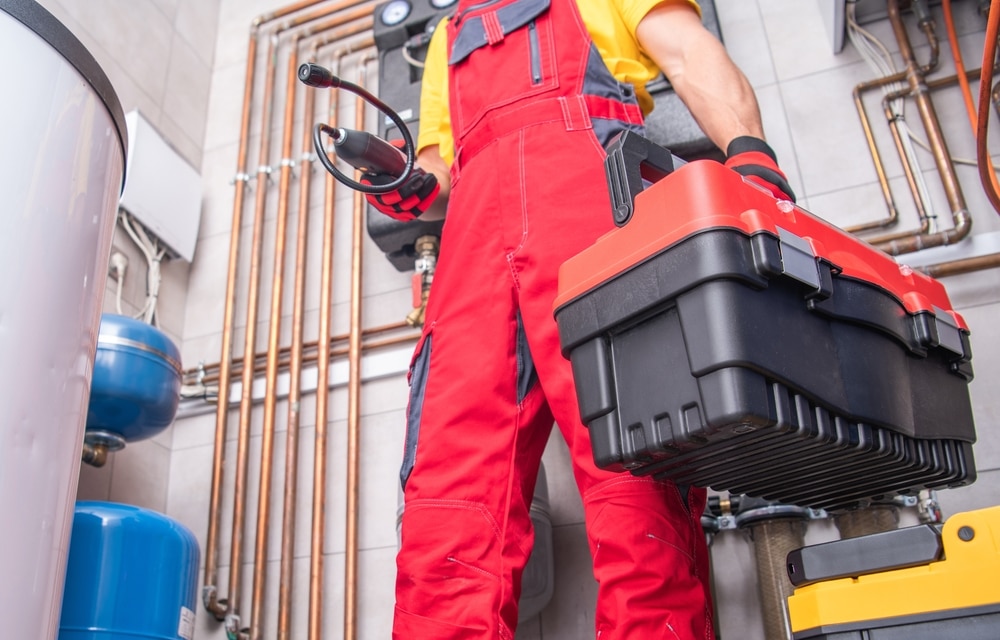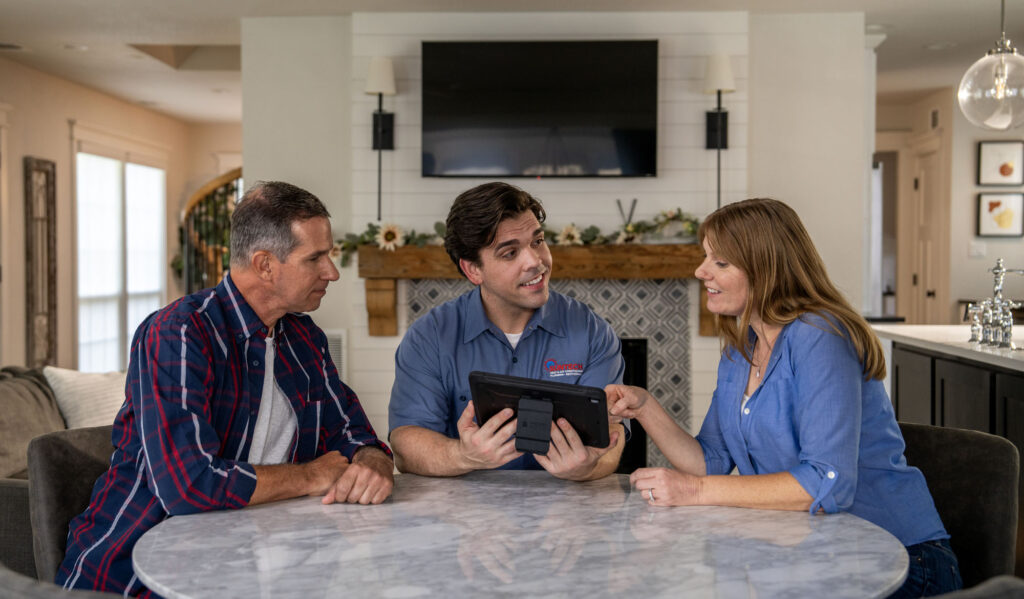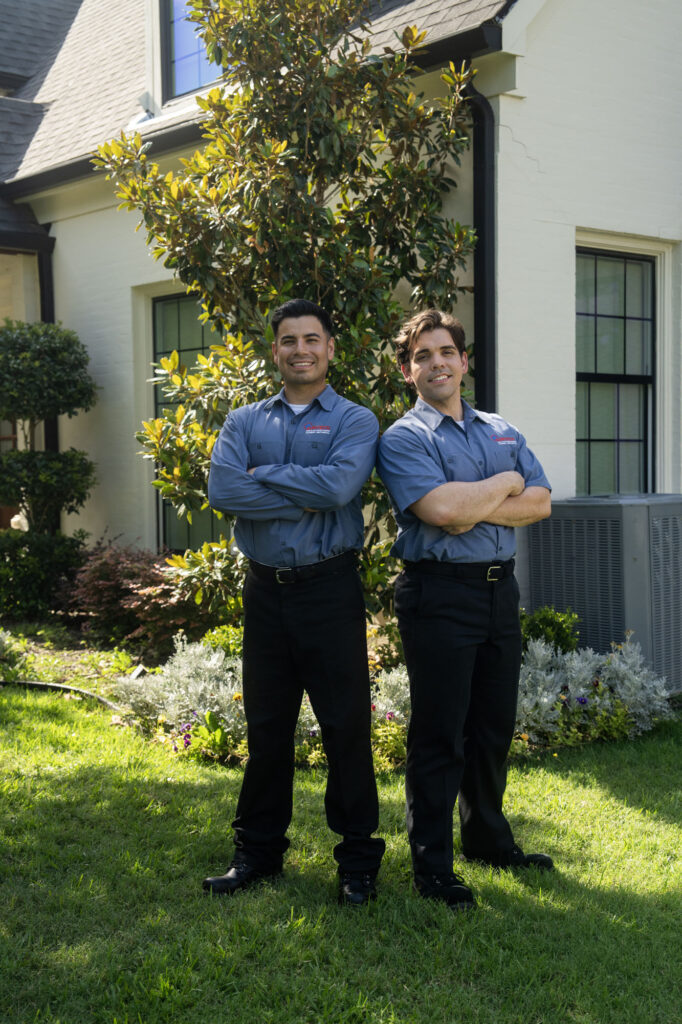Blog
5 Signs Your Furnace or Heat Pump Is Going Out

The only thing predictable about Oklahoma weather is its unpredictability. We can go from 70 degrees one day to ice and snow the next, and the first surprise cold snap is not the time to find out your furnace or heat pump needs attention. Oklahoma’s finicky weather means your home’s heating source always needs to be ready for action.
First, you need to know the type of heater you have. Most homes in Oklahoma are heated with an electric heat pump or a gas/natural gas furnace, though furnaces can also be oil or electric.
Gas, Electric, and Oil Furnaces
A furnace serves as a central heating unit and burns gas (like propane or natural gas) to generate heat. A flame from a pilot light or electronic ignition activates the gas inside the unit to warm the air in it, which is then distributed throughout the house via a system of vents and ducts.
A furnace has 4 main components:
- The burner burns the fuel needed to heat the air (an electric furnace blows air over a hot element, similar to a hairdryer).
- A heat exchanger transfers heat and circulates it throughout the house.
- A blower distributes the heat.
- A flue removes gaseous by-products, like carbon monoxide.
When properly maintained, a furnace can have a lifespan of 15-20 years, and with just a few main components, furnaces typically require less maintenance and don’t tend to break down often in their early years; annual maintenance and servicing are usually enough to keep it operating at peak performance. Furnaces—especially oil furnaces—are more common in older homes or very cold climates. (Oil furnaces can last up to 30 years with proper maintenance, but often require more cleaning and air filter changes than other types.)
Heat Pumps
Unlike furnaces, which create heat and blow it into your house, a heat pump draws heat from outside air and transfers it indoors. The heated air is transformed into a gas, which heats a coil that moves the hot air into the home.
Heat pumps run on electricity and—because they don’t burn fuel—do not need an ignition point. They are a popular alternative to furnaces and, with both an indoor and outdoor unit, can serve to both heat and cool your home. Most heat pumps have a lifespan of about 15 years.
A heat pump consists of several components, but the three primary ones are:
- An outdoor unit (an evaporator in heating mode), with a fan that blows outside air over a coil to heat it.
- An indoor unit (a condenser in heating mode), which moves air across another coil and throughout the home’s ductwork.
- A compressor, which circulates refrigerant between the indoor and outdoor units.
Regardless of what type of equipment heats your home, they all need to be maintained for their most efficient operation, and they all share similar warning signs if something is amiss.
5 Warning Signs Your Furnace or Heat Pump Needs to Be Replaced
- Noise. Some noise is normal. Heat pumps tend to be a little noisier during regular operation, making some clicking or knocking sounds, and a properly-operating furnace will make a soft whoosh or whirring as it turns on. A lot of noise at startup or during operation—including wobbling, rattling, banging, groaning, squealing, screeching, whining, or irregular humming—is not normal and means your furnace or heat pump needs some attention. A wobbling or rattling when the fan starts up, for example, could indicate a problem with the blower motor’s bearing.
- Smells. As with the noise, some smells from your furnace or heat pump is normal, especially the first time you turn it on for the winter season. There may be a mild burning or musty smell as the furnace burns off any dust or dirt that has accumulated on the blower and heat exchanger. However, this should fade within the first few hours of operation; if it lingers much longer than 24 hours, it may be a sign of a bigger problem.
- A lingering musty, mildew-like smell can be a sign of clogged or dirty air filters and may be remedied by changing the filters. However, it could also be the result of moisture that has built up in the ducts, causing mold that could be dispersed throughout your house. Your best bet is to call in a professional to evaluate your system.
- A burning, metallic, or smoky smell can indicate parts of the system—such as wiring, a fan motor, or electrical components—are overheating or even burning. This can also produce a smell similar to burning plastic, rubber, or oil. Turn off the heating unit and call an HVAC technician.
- Rotten eggs. One smell you should never ignore from your gas furnace is the smell of rotten eggs or sulfur. Gas companies put a chemical in propane and natural gas that produce the smell, and it is a sign that there is a possible gas leak in your unit. You should turn off the furnace immediately and call your gas company, an HVAC professional, and 911. If possible, you may also want to leave the home until the problem is resolved; propane and natural gas are highly volatile and the smallest spark can trigger an explosion.
- Won’t turn on. If you’re having trouble turning on your furnace or heat pump and keeping it going, or if you have to restart it several times a day, there are a few troubleshooting steps you can take before calling a professional. Make sure the thermostat is on with working batteries and set to heat. You can also make sure the pilot light on your gas furnace is still ignited and check the gas supply by testing other gas-operated appliances. If none of those improves your unit’s operation, it’s time to call an HVAC technician.
- Water near the unit. While some moisture or condensation on the outside of your unit is expected, water leaking inside your home or around your heating unit is not. This could be the result of a damaged heat exchanger, a compromised seal on the evaporator coil of a heat pump, or a problem with the condenser.
- Signs of carbon monoxide emissions. While heat pumps run on electricity and pose no threat of carbon monoxide poisoning, the heat exchanges and combustion chambers in oil or gas furnaces can crack as they age, leaking carbon monoxide into your home. Signs that there may be carbon monoxide present in your home include rusting on pipes; a yellow furnace burner flame instead of a blue one; excess moisture on the windows, walls, and other surfaces; streaks of soot around the furnace; no updraft in the chimney; and frequent flu-like symptoms, such as headaches, nausea, disorientation, or a burning feeling in the nose or eyes. Like gas leaks, carbon monoxide leaks are extremely dangerous to you and your family and need to be resolved immediately.
Other Indications Your Heating System Needs Servicing
- Uneven heating. If you’re finding yourself constantly adjusting your thermostat and struggling to make your home comfortable, your furnace or heat pump may be having problems properly distributing the air in your home. You may also notice that your unit—especially your heat pump—is producing less warm air than before, blowing cold air, taking a long time to heat your home, or is running through irregular cycles. Short or frequent cycles can result from problems like dirty burners, filters, or flame sensors, or a malfunctioning ignitor, while excessively long run times could be caused by a cracked, malfunctioning, or dirty heat exchanger. They may also be signs that your unit isn't the right size for your home. If it's too big, the output will be too powerful and your system will be straining not to overheat; if it's too small, it won't have the power it needs to heat your home and will work harder and longer than it should.
- Your house is very dry and/or dusty, or you are noticing poor air quality. This is often an indication that the heating unit is not cleaning or moisturizing the air in your home properly. You may also notice dust accumulation, static, or cracking furniture, or an exacerbation of allergies and dry throats, skin, and noses.
- An increase in your energy bills. Your energy bill will naturally fluctuate with the change in seasons—especially in Oklahoma—but a steady increase over time or a dramatic jump in your utility expense may indicate that your furnace or heat pump is beginning to operate less efficiently and needs serviced or even replaced.
Should I Repair or Replace My Furnace?
Whether or not you should repair or replace your heat pump or furnace depends on:
- The age of your system
- The cost of repair vs the cost of replacement
- Your budget and comfort goals
The cost of repair is determined by the amount of time it takes to make the repair and the cost of the replacement part. Minor repairs are less time- and labor-intensive, and the necessary parts tend to be less expensive, so it may be more cost-effective to repair rather than replace your furnace or heat pump. Minor repairs may include replacing the:
- Transformer, which supplies electricity to the furnace. Transformers rarely fail, but if they do, it’s likely because of electrical stress like short cycling.
- Pressure switch, one of the furnace’s many safety switches that is most prone to failure
- Ignitor, which provides the spark for heating the home
- Sequencer, which powers an electric furnace’s heat strips
A good rule of thumb is if your oil or natural gas furnace is less than 12 years old and properly maintained, you probably don’t need to worry about replacing it any time soon.
If your heat pump or furnace needs a major repair, however, it may be better to replace the entire unit than make the repair. A major repair that exceeds 50% of the cost of a replacement unit probably warrants a replacement instead. (For older systems that are beyond 75% of their operational life expectancy, replacements are recommended if the repair exceeds 1/3 or 33% of the cost of a replacement.)
Major heat pump repairs could include malfunctions with the:
- Heat exchanger, the biggest component, which heats air that the blower motor then distributes
- Blower motor, which circulates air throughout the home
- Circuit board, which keeps the furnace functioning properly in the home heating cycle
- Inducer motor, which moves air within the furnace
- Gas valve replace, which supplies the furnace with fuel
- Compressor (heat pump)
- Evaporator coils (heat pump)
- Ductwork problems
- Computerized parts or any component of the electrical system/electronics/control board
Always Replace an Oil or Gas Furnace That's Leaking Gas or Carbon Monoxide
The worst time to make a decision about repairing or replacing your furnace or heat pump is in the middle of an emergency. If your unit is nearing the end of its lifespan (about 20 years for an oil, gas, or electric furnace and about 15 years for a heat pump) or if it was installed over 15 years ago, it may be time to start thinking about replacing it. Planning ahead gives you time to do your research and compare products and prices so you can make the best decision possible.
You should also start considering a replacement furnace if you:
- Could be eligible for state and local tax credits for installing a high-efficiency system. You may be able to enjoy these one-time benefits, as well as incentives from local utility companies and savings on your monthly bills. Replacing an older unit with a high-efficiency Energy Star-rated heating unit could save you as much as 20% in heating costs.
- Are selling your home in the next few years. Upgrading your heating system could add significant resale value to your home.
- Are experiencing frequent expensive repairs. Furnaces and heat pumps tend to incur the most mechanical breakdowns in the last two years of their serviceable lifespan. If you’re finding yourself frequently having to repair your unit, or if replacement parts are becoming difficult to track down, your system may be outdated and it may be time for a new one.
Prevent Future Furnace or Heat Pump Problems With Suntech Heat and Air
There are two easy ways to help ensure your furnace or heat pump is always ready for wild Oklahoma weather:
- Change the system’s air filters regularly to minimize dust buildup and prevent system clogging and overheating. Whether you have a heat pump or a furnace, you should change the system air filters every 6 months.
- Schedule regular maintenance, including an annual tune-up, with Suntech Heat and Air.
Suntech Heat and Air has been keeping Oklahomans warm for more than 30 years. Our team of experienced, knowledgeable, and licensed technicians are trained to service all makes and models of oil, gas, and electric furnaces as well as heat pumps. Our comprehensive 15-point inspections mean we don’t miss a thing, and we’re proud to offer 24/7 emergency service with no overtime fees for nights, weekends, or holidays and no extra charges for emergency calls.
Be confident in a heating system that will carry you through the ups and downs of Oklahoma winters. We make keeping your home comfortable affordable and convenient with $89.95 furnace tune-ups and $500 of a complete system installation if you need a replacement. Contact us today at 405-785-0950 or by emailing us at [email protected].




